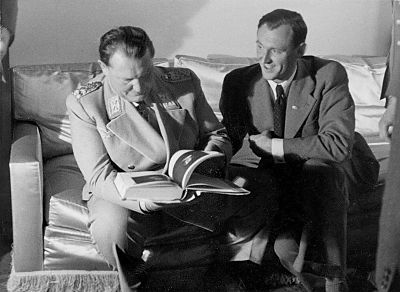
Plunderer: The Life and Times of a Nazi Art Thief | JIFF 2025
Click here if you liked this article 3 ![]()
Date Reviewed: 25/10/2025
The world of art has always fascinated me. A world where beauty, power and money collide in such mind-blowing proportions. The allure is undeniable, and naturally, this attracts both those driven by passion, and those driven by greed. Art has been inseparably intertwined with some of the largest figures and historical events in the world. Plunderer: The Life and Times of a Nazi Art Thief explores one story that seems too surreal to be true and yet could only be true because art and the rules that bind it are so elusive. Welcome to the extraordinary life of Bruno Lohse.
Historian Jonathan Petropoulos immediately draws us into Lohse’s life at the point where they first met. To admit to beginning a decade-long relationship with a known Nazi and war criminal, someone who was in close alliance with one of the most powerful men in the Third Reich, Hermann Göring, requires some introspection on Jonathan’s behalf. But, as he states, one needs to be close to unveil the secrets Lohse held, and Jonathan’s role as narrator does that unveiling justice, captivating the viewer and providing an accurate insight into not just Lohse’s life but the art looting and trade at the hands of the Nazis.
Jonathan takes us on a global tour as we follow Lohse across Europe and the United States, during wartime and the post-war decades, and how Lohse exploited the shift between these two eras. We hear so much about Nazi Germany, and yet what stuck with me the most after watching Plunderer was this: in a country scarred by its recent history, where many people wanted to forget, former Nazis still lived and held powerful positions among the people. Those seeking help or in search of sentimental family heirlooms – such as art – confiscated by the Nazis were told to move on and leave the past in the past. There was no return of belongings, no impactful repercussions, no closure for many of these families. Provenance of artworks was obscured, and art dealers were acquitted on grounds they were ‘saving art’. This is what sets the art world apart from other criminal activity; offenders often get away with it and are even celebrated for doing so.
Where there’s power and money, there are secrets. What draws you into this story continuously deeper is the search for answers. Right until the very end, the more information revealed, the more twists occur, and the more questions are raised. Bruno Lohse led a life with so many secrets tucked away in his past that the truths and the lies had become so twisted, to the point where, as a viewer, I don’t believe Lohse himself, by the end of his life, knew what the truth was anymore.
In the creation of every piece of artwork lies a timeline; layers of history, intention and circumstance that shape how that work came to be. Plunderer is one such piece, layering detail upon detail to form a hauntingly subtle work of art. It transforms an unsettling chapter of world history into something both gripping and strangely digestible.
Reviewed by Juliet Morelli